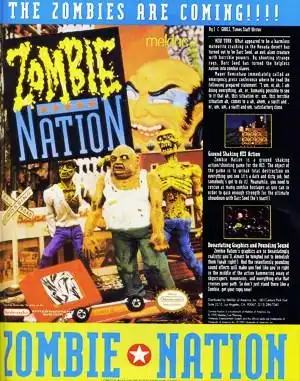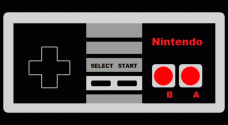The late 80s and early 90s on the Nintendo Entertainment System gave us some truly unforgettable games. We had platformers, RPGs, and action titles that defined a generation. And then, there was Zombie Nation. Even by NES standards, this game was... different. If you thought you'd seen it all, prepare yourself for a tale of floating samurai heads, zombified Americans, and alien invaders.
Released in 1990 by KAZe and published by Meldac, Zombie Nation is a horizontal shoot 'em up that quickly earned a reputation not just for its difficulty, but for its utterly bonkers premise. It's a game that screams "cult classic" from its title screen to its bizarre final boss.
What Exactly Is Zombie Nation?
At its core, Zombie Nation is a side-scrolling shmup, a genre popular during the 8-bit era. You move your character across the screen, blasting everything in sight while dodging enemy fire and environmental hazards. So far, so standard, right?
Not quite.
The defining feature, and the source of much of its notoriety, is the player character. Instead of a spaceship or a soldier, you control the giant, disembodied, levitating head of a samurai named Namakubi. Yes, a floating head. Your mission? To save the United States from an alien entity.
The Bizarre Premise: Floating Heads and Zombified America
The year is 1999 (a futuristic setting at the time!). A meteor, known as "Darc Seed," crashes in the Nevada desert. This isn't just any space rock; it's an alien entity that emits magnetic rays, turning the entire population of the United States into zombies. As if that weren't enough, Darc Seed also takes control of the nation's weaponry and, crucially, gets its hands on the legendary samurai sword, Shura.
Hearing of this calamity and the fate of the sword, the floating samurai head, Namakubi, travels to the US to confront Darc Seed, free the zombified population, and reclaim Shura. It's a story that defies logic, embraces absurdity, and is perfectly suited for the wild west of 8-bit gaming narratives.
Gameplay: Spit, Vomit, and Bullet Hell?
Controlling a giant floating head is exactly as strange as it sounds. Namakubi moves with a certain inertia, feeling heavy compared to typical shmup sprites. Your primary attacks are projectiles shot from your eyes and mouth – often described as eyeballs and vomit. Charming, isn't it?
Key gameplay elements include:
- Destructible Environments: Many buildings and structures can be destroyed, often revealing hidden power-ups or zombified hostages.
- Rescuing Hostages: Freeing the zombified humans trapped in buildings upgrades your firepower.
- Life Bar: Unlike many 8-bit shmups with instant death, you have an 8-unit life bar. Taking damage depletes it, and the music gets more frantic when you're low on health.
- Instant Kills: Despite the life bar, certain hazards like crushing walls or specific boss attacks can still result in instant death, adding to the challenge.
- Stage Selection: Initially, you can choose which of the first four stages to tackle, adding a non-linear element before proceeding to the final, linear levels.
The game is known for its difficulty, often due to the combination of Namakubi's size, the screen's relentless scrolling, and tricky enemy patterns. Those instant-kill lasers and environmental traps require careful navigation.
East Meets West: Abarenbou Tengu vs. Zombie Nation
Like many games of the era, Zombie Nation had a different identity in Japan. It was originally released as Abarenbou Tengu (暴れん坊天狗), which translates roughly to "Rowdy Tengu."
The most significant difference? The player character sprite. In Abarenbou Tengu, you control a Tengu mask, a mythical Japanese creature. For the US release, this was changed to the decapitated samurai head, Namakubi. This change necessitated minor graphical and narrative tweaks, but the core gameplay remained largely the same. The Japanese version also required collecting a power-up for rapid fire, whereas the US version starts with it.
This regional difference adds another layer to the game's weird legacy, highlighting how developers sometimes localized games in truly unique ways.
Why the Cult Status?
Zombie Nation wasn't a massive mainstream hit, but it carved out a niche and gained a dedicated following over the years. Its cult status stems from:
- The Unforgettable Premise: It's simply one of the strangest concepts ever put into a video game. A floating samurai head saving America from alien zombies? It's hard not to remember that.
- Surprisingly Solid Gameplay: Beneath the bizarre exterior lies a competent, albeit tough, horizontal shooter.
- Unique Visuals: Despite the NES's limitations, the game featured detailed backgrounds, large sprites (including your own head!), and satisfying destruction effects, though sprite flickering could be noticeable.
- Nostalgia: For those who played it back in the day, its weirdness is intertwined with fond memories of exploring the limits of 8-bit creativity.
It's the kind of game you tell your friends about just to see their reaction.
Playing Zombie Nation Today
If you're feeling nostalgic or simply curious about experiencing this piece of retro gaming history, you have a few options beyond tracking down an original (and potentially expensive) NES cartridge:
- Modern Re-release: In 2021, City Connection released Abarenbou Tengu & Zombie Nation for Nintendo Switch and PC (via Steam). This bundle includes both the Japanese and US versions, often with quality-of-life features like save states, rewind, and rapid-fire toggles, making the challenging game more accessible.
- Emulation: For historical preservation and educational purposes, the game can be played via emulators like DOSBox or MAME, though finding the ROMs requires navigating complex legal and ethical waters.
Experiencing Zombie Nation in its original form or via a modern port is a must for any retro game enthusiast looking for something truly off the beaten path.
Final Thoughts
Zombie Nation is more than just a weird game; it's a testament to the creative freedom and sometimes baffling design choices of the 8-bit era. It's a game that didn't take itself too seriously, delivering a challenging shmup experience wrapped in a premise so outlandish it's impossible to forget.
Whether you remember battling the zombified Statue of Liberty as a kid or are discovering this gem for the first time, Zombie Nation remains a fascinating, bizarre, and undeniably cool piece of retro gaming history. Give it a try – your brain might just thank you (or question your sanity).
FAQ
Q: What console was Zombie Nation originally released on? A: Zombie Nation was originally released on the Nintendo Entertainment System (NES) in 1990.
Q: What's the difference between Zombie Nation and Abarenbou Tengu? A: They are essentially the same game, but Abarenbou Tengu is the Japanese version where you control a Tengu mask sprite, while Zombie Nation is the US version where you control a floating samurai head (Namakubi). There are also minor gameplay tweaks like starting with rapid fire in the US version.
Q: Is Zombie Nation a hard game? A: Yes, Zombie Nation is known for being quite challenging, featuring tricky enemy patterns, environmental hazards, and instant-kill traps, though the modern re-release adds features to make it more accessible.
Q: Can I play Zombie Nation on modern systems? A: Yes, a bundle titled Abarenbou Tengu & Zombie Nation was released in 2021 for Nintendo Switch and PC (Steam), containing both versions of the game with modern quality-of-life features.


